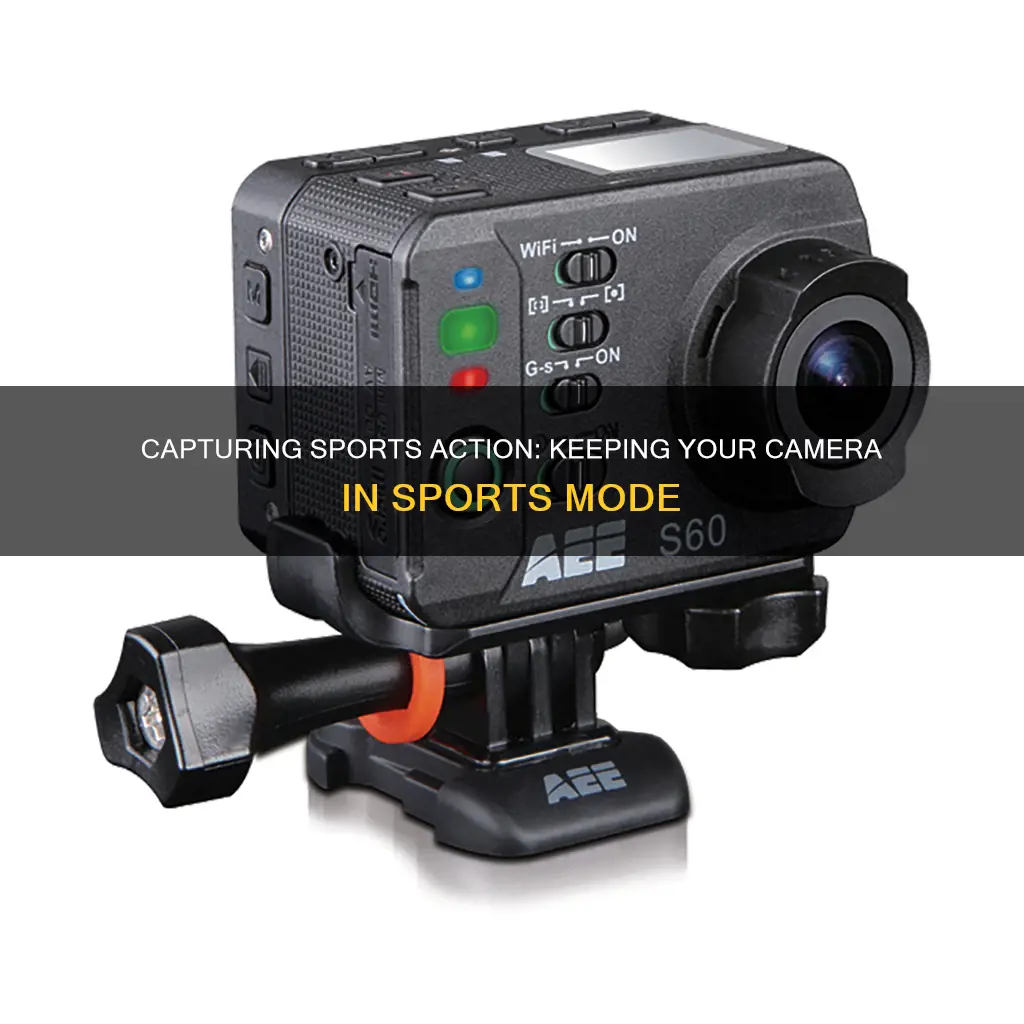
Sports mode is a camera setting that optimises your device's configuration for fast-action scenes. It is one of the many 'Scene modes' designed to help beginner photographers take better photos without having to delve into more complex settings. Sports mode adjusts variables such as ISO, f-stop, shutter speed, drive mode, and autofocus to make it easier to capture fast-moving subjects. While it may not be ideal for professional photographers aiming for high-level sports photos, it can be a handy tool for newbies looking for more consistency than what Auto mode offers. In this article, we will explore the ins and outs of Sports mode, including how to enable it on your camera and how to use it effectively to boost your success rate when photographing sports and action scenes.
| Characteristics | Values |
|---|---|
| Shutter Speed | 1/500 of a second or faster |
| Aperture | Wide aperture, f/4 and f/5.6 |
| ISO | 400 or above |
| Drive Mode | Continuous |
| Autofocus | Continuous and tracking |
What You'll Learn

Use a fast shutter speed to freeze motion
Capturing motion in sports photography is a tricky business, but the results can be incredible. To freeze motion, you need to use a fast shutter speed. The faster the sport, the faster the shutter speed you will need.
Shutter speed is the most important thing to get right in sports photography. If your shutter speed is too slow, you will be left with blurry, disappointing shots. A fast shutter speed is essential to freeze motion. The gold standard for a professional sports photographer is a fast shutter speed of 1/1000, but you may need to go even faster for very fast-moving sports. For example, for sports like racquetball, you may need to use a shutter speed of 1/1,600 or faster.
The shutter speed you need will also depend on the lighting conditions. The faster the shutter speed, the less light will reach the camera's sensor. So, if you are shooting in a well-lit area, you can use a faster shutter speed. If you are shooting in a darker environment, you will need to use a slower shutter speed to allow more light to reach the sensor.
You can start by putting your camera into Shutter Priority mode and choosing a shutter speed of 1/500 of a second. This is a good starting point and will be fast enough for most sports. Take some test shots to check for sharpness and adjust your shutter speed if necessary.
To reach the high shutter speeds required for sports photography, you will need to use a wide aperture. This will let in more light and help to blur the background, keeping the focus on the players. If you are using a zoom lens, it is best to set your lens to the middle of its range. This is a good compromise between filling the frame and letting in enough light.
Using a fast shutter speed may mean that your camera struggles to expose the scene properly. If this happens, you will need to increase your ISO speed. It is best to use the lowest ISO setting you can, but there may be situations where you need to increase it to get the shot.
Using a fast shutter speed will help you to freeze the action and capture those incredible sports moments.
Adjusting Midtones in Camera Raw: A Step-by-Step Guide
You may want to see also

Increase the ISO to a higher setting
Increasing the ISO to a higher setting is a crucial adjustment when using Sports mode to capture fast-action scenes. This setting boosts the exposure, allowing for a faster shutter speed to freeze the action and prevent blurry images. Typically, Sports mode sets the ISO to 400 or above, but the specific value depends on lighting conditions and lens selection.
ISO is one of the three pillars of photography, along with shutter speed and aperture. It controls the camera's sensitivity to light, directly impacting the brightness of the image. By increasing the ISO, you make the sensor more sensitive to light, resulting in brighter photos. This is particularly useful when capturing images in low-light environments or when you need to use a faster shutter speed to freeze fast-moving subjects.
However, it's important to remember that raising the ISO has consequences. Images taken at very high ISO settings may exhibit noticeable grain or noise, which can degrade the overall quality. Therefore, it's a trade-off—you should only increase the ISO when necessary, such as when you can't achieve the desired brightness through shutter speed or aperture adjustments.
When using Sports mode, the camera automatically adjusts the ISO to higher settings to accommodate the fast-action nature of sports and action photography. This ensures that you can capture sharp and focused photos of athletes in motion, like a football player sprinting or a basketball player dunking.
Additionally, Sports mode also reduces the f-stop (widening the aperture) to create a shallower depth of field, further isolating the subject from the background. This combination of higher ISO and wider aperture allows for faster shutter speeds, increasing your chances of capturing the perfect shot at the right moment.
Japan Camera Import: Customs and Charging
You may want to see also

Reduce the f-stop to widen the aperture
When shooting sports, it's important to set up your camera properly before the event begins so that you can focus on capturing the movement and excitement of the game. One way to do this is by adjusting the f-stop setting on your camera.
The f-stop setting controls the aperture, which is the hole in your camera's lens that lets light pass through. Lowering the f-stop will widen the aperture, allowing more light to enter the camera and creating a shallow depth of field. This is particularly useful when shooting sports, as it helps to blur the background and isolate the action in the scene, ensuring that the viewer's focus is on the main subject.
To achieve this effect, it's recommended to use a fast lens with a wide maximum aperture. This will enable the camera to capture more light and create a more pronounced background blur. Additionally, using a long lens with a focal length of 50mm or more will provide a tighter framing and further enhance the separation between the subject and the background.
It's worth noting that while lowering the f-stop can improve sports photography, it may not be suitable for all situations. Landscape photographers, for example, often prefer using higher f-stop values to keep both the foreground and background in focus. Nonetheless, for sports photography, a lower f-stop can be a powerful tool to capture dynamic and exciting images.
Understanding Camera Raw Histogram: A Beginner's Guide
You may want to see also

Set the drive mode to continuous
Setting the drive mode to continuous is an important step when using your camera's Sports mode. This will ensure that you capture multiple photos in quick succession, increasing your chances of getting the perfect shot. Here's a detailed guide on how to set your camera to continuous mode:
- Locate the Drive Mode Setting: The drive mode setting can usually be found as a physical dial on your camera, or you may need to access it through the menu. It is often labelled as "Continuous Shooting" or "Burst Mode".
- Activate Continuous Mode: The specific steps to activate continuous mode may vary depending on your camera model. On some cameras, you may need to press a certain button (e.g., the left Cross key button) and then rotate a dial to select the continuous mode option. Refer to your camera's manual for detailed instructions.
- Capture Photos: Once you have activated continuous mode, simply depress and hold the shutter button until the desired number of frames has been captured. Your camera will continue taking pictures as long as you hold down the shutter button.
- Manage Memory Card Space: Keep in mind that shooting in continuous mode will fill up your memory card much faster than taking individual shots. Ensure that your memory card has sufficient capacity, and consider bringing a spare card if needed. Alternatively, take advantage of breaks or timeouts to delete unwanted photos and free up space.
- Understand Buffer Limitations: Your camera has an internal memory buffer where images are temporarily stored during processing before being moved to your memory card. If you shoot continuously at a high speed, the buffer may fill up, causing the camera to slow down or display the "Busy" message. To avoid this, manage your image format, memory card speed, and file size.
By setting the drive mode to continuous, you can capture fast-moving subjects and action-packed moments with greater success. This is particularly useful for sports photography, allowing you to freeze the action and choose the best shots from a sequence of captured images.
Replacing Li-ion Camera Batteries: A Step-by-Step Guide
You may want to see also

Adjust autofocus modes to continuous and tracking options
When adjusting your autofocus modes to continuous and tracking options, you'll want to select the Continuous Focusing mode (AI Servo on Canon, AF-C on Nikon, and Continuous Servo on Sony) . This is the mode you need to be in when
Another mode, AI Focus, is a hybrid of the two modes. If the subject is moving, it keeps on tracking, but if it stops, it will lock. This setting is interesting, but for sports photography, it's best to stick with the continuous focus mode.
Different sports have different requirements, so you may need to adjust your autofocus settings accordingly. For example, if your subject tends to travel in a straight line or is not particularly fast-moving, it's suggested that you choose the single-point AF mode when in the AF-C setting (Nikon/Sony). However, with subjects that move unpredictably, such as athletes in a football game or hockey match, other modes such as "Zone", "Expand", "Wide", or "Flexible Spot M" in the Sony menu, should get you better results.
When shooting sports, it's also important to remember to keep the action near the middle of the frame. Many cameras have the majority of their focus points in the centre, so by placing your main subject in that area, you increase your chances of capturing an in-focus shot.
Additionally, some DSLR and mirrorless cameras have touch focus control, allowing you to establish the focus point by touching that point on the LCD monitor. This can be helpful when trying to track a fast-moving subject.
Finally, a setting called Back Button Focusing can be a powerful tool for sports photographers. This setting allows you to control your focus with your thumb on the back of your camera by pushing a designated button. This gives you more control and can help you capture the moment more quickly and with steadier hands.
Choosing the Right Camera Battery: Maximizing Power
You may want to see also
Frequently asked questions
The sports mode option is usually found on the main mode dial, indicated by a running person icon. However, if you can't find it there, consult your camera's manual or search through its internal menu options.
The ideal setting for sports photography is a fast shutter speed to freeze the action, a wide aperture to let in more light and blur the background, and a high ISO for better exposure.
A telephoto zoom lens is ideal for sports photography as it allows you to get closer to the action. For crop sensor cameras, a lens with a focal length longer than 70mm should work well.
Switch from multi-point to single-point focusing and use the focus point at the centre of the frame. This will allow your camera to focus on the subject in the centre rather than trying to keep everything in focus.
Use a long lens with a focal length of 50mm and above, and the fastest lens you own. You don't need a tripod as the increased shutter speed and ISO will make hand-holding the camera easier. Keep the action near the middle of the frame to increase your chances of capturing an in-focus shot.







